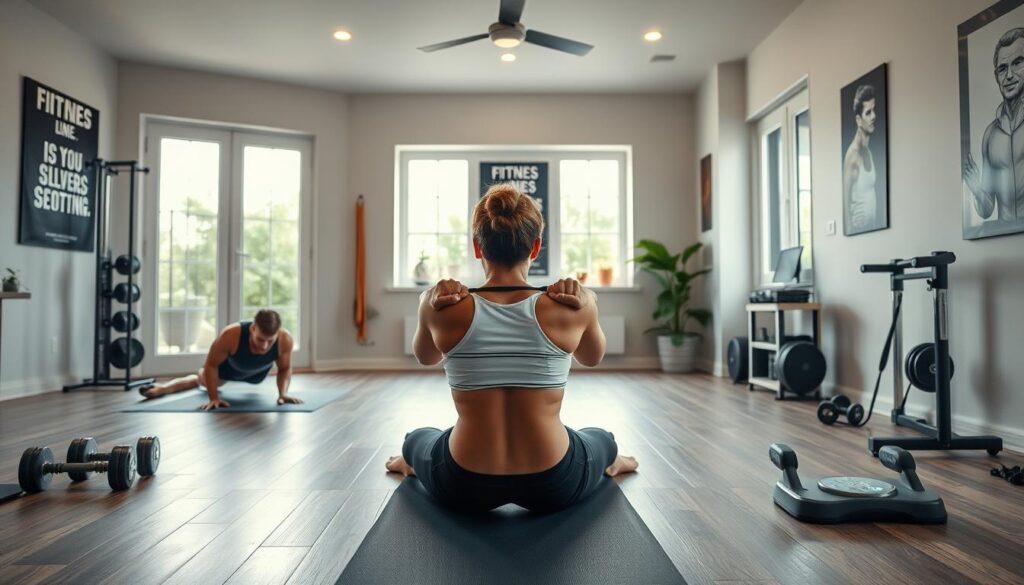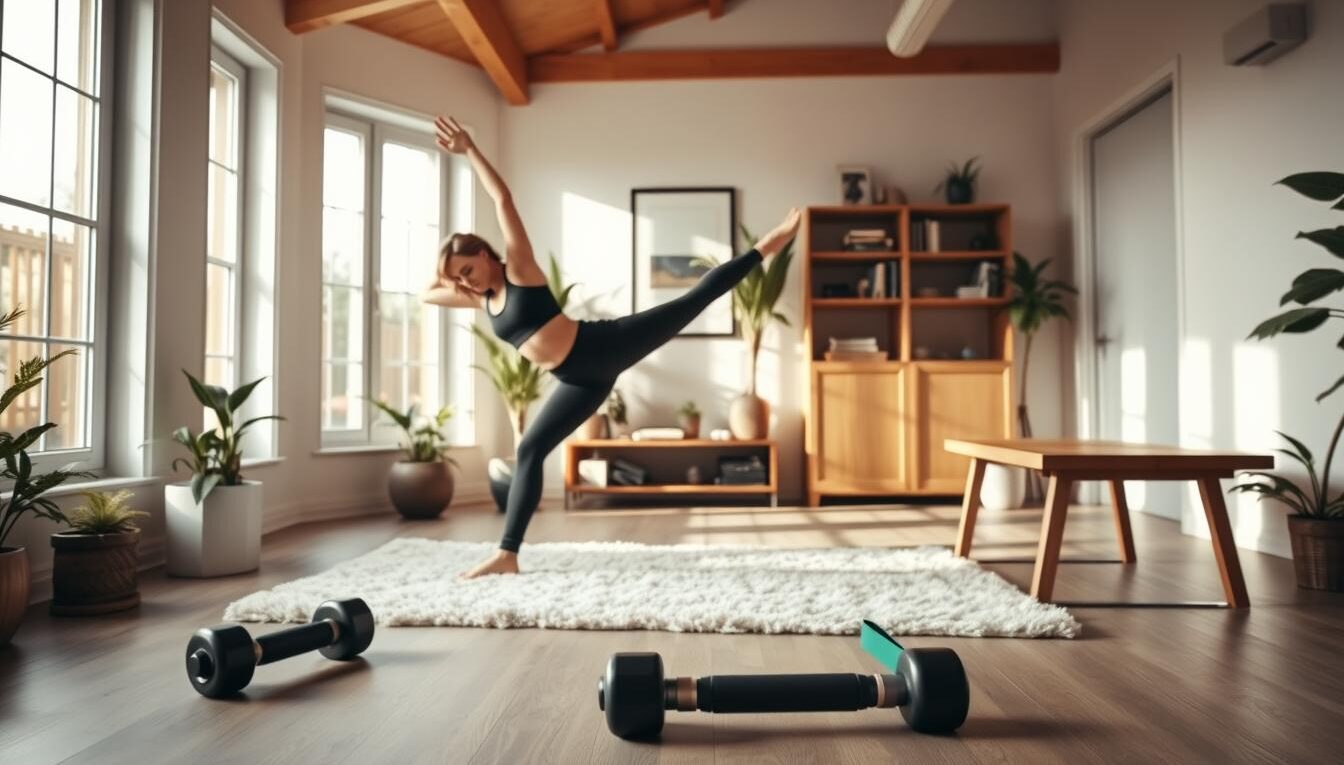How to Create a Weight Loss Routine Without the Gym
You don’t need a gym membership to achieve your weight loss goals. With a gym-free workout routine, you can transform your body from the comfort of your own home.
A well-structured weight loss routine involves a combination of regular home exercise and healthy lifestyle changes. By focusing on simple yet effective workouts, you can kick-start your journey towards a healthier, fitter you.
Key Takeaways
- Start with simple bodyweight exercises at home.
- Incorporate cardio and strength training into your routine.
- Make healthy dietary changes to support your weight loss.
- Stay consistent and track your progress.
- Find a workout buddy or join online fitness communities for motivation.
Understanding Weight Loss Fundamentals
Understanding the core principles of weight loss can make all the difference in your journey to a healthier you. At its core, weight loss is about creating a calorie deficit, where you burn more calories than you consume.
The Calorie Deficit Principle
A calorie deficit is achieved through a combination of reducing your caloric intake and increasing your physical activity. This doesn’t necessarily mean you have to be overly restrictive or spend hours at the gym. Simple changes, like eating more vegetables and taking the stairs, can contribute to a calorie deficit.
Why Movement Matters Beyond the Gym
Movement is not just about gym workouts; it’s about incorporating activity into your daily life. This can include walking, gardening, or even household chores. Every bit of movement counts towards your overall energy expenditure, helping to create that crucial calorie deficit.
Setting Realistic Expectations
It’s vital to have realistic expectations when starting a weight loss journey. Losing weight too quickly is not healthy and is unlikely to be sustainable. Aim for gradual weight loss, and remember that it’s not just about the number on the scale but also about adopting a healthier lifestyle.
By understanding these weight loss fundamentals, you’re better equipped to make informed decisions that support your goals. Incorporating natural methods, such as dietary changes and increased physical activity, can lead to sustainable weight loss.
Assessing Your Current Fitness Level
Understanding your current fitness level is key to setting realistic and achievable weight loss goals. As fitness expert Joe Cirulli once said, “You can’t manage what you don’t measure.” This principle applies perfectly to your fitness journey. By assessing where you are now, you can create a more effective plan tailored to your needs.
Simple At-Home Fitness Tests
You can easily assess your fitness level without any special equipment. Try simple tests like counting how many push-ups you can do in a row, measuring how long it takes you to walk a mile, or seeing how many stairs you can climb before getting tired. These tests give you a baseline of your current cardiovascular endurance and muscular strength.

Setting Realistic Weight Loss Goals
Aim to lose 1-2 pounds per week for a sustainable weight loss. Setting achievable milestones helps keep you motivated throughout your journey.
Creating Your Baseline Measurements
Take your baseline measurements by recording your weight, body fat percentage, and taking body measurements. According to
“The only bad workout is the one that didn’t happen.”
by Joe Cirulli, tracking your progress is essential. Regularly updating your measurements will help you stay on track and adjust your plan as needed.
By following these steps, you’ll be well on your way to creating a weight loss plan that’s tailored to your needs and abilities.
Creating Your Home Exercise Space
With a little creativity, you can turn any corner of your home into a functional workout area. The key is to identify the space you have available and think about how you can best utilize it for your fitness needs.
Minimal Equipment Recommendations
You don’t need to invest in a lot of equipment to get started. Resistance bands and a good yoga mat are excellent starting points. They are affordable, take up minimal space, and can be used for a variety of exercises.
- Resistance bands for strength training
- A yoga mat for comfort and grip during exercises
- A jump rope for cardio workouts
Making Space in Small Living Areas
Even in small apartments, there’s often a corner or a section of a room that can be repurposed for working out. Consider the layout of your home and think about how you can make the most of the space you have. Foldable equipment and wall-mounted storage can be lifesavers in small spaces.
Budget-Friendly Alternatives to Gym Equipment
There are many creative ways to work out at home without expensive gym equipment. For example, you can use water bottles as dumbbells or do bodyweight exercises that require no equipment at all. You can also look for second-hand equipment or DIY projects online.
By being resourceful and flexible, you can create an effective home exercise space that fits your budget and lifestyle.
Bodyweight Exercises for Maximum Calorie Burn
Bodyweight exercises are a powerful tool for burning calories and can be done from the comfort of your own home. These exercises utilize your own weight as resistance to build strength, improve cardiovascular health, and burn calories.

Full-Body Workout Routines
Full-body workout routines engage multiple muscle groups simultaneously, maximizing calorie burn and improving overall fitness. Examples include:
- Burpees: A comprehensive exercise that combines a squat, push-up, and jump.
- Mountain climbers: A cardio-intensive exercise that targets the core and legs.
- Squats: Works the legs and glutes while engaging the core.
- Push-ups: Targets the chest, shoulders, and triceps.
- Lunges: Effective for the legs and glutes.
These exercises can be combined into a circuit to create a high-intensity workout. For instance, doing 3 sets of 10 burpees, followed by 3 sets of 20 mountain climbers, can be an effective full-body workout.
Modifying Exercises for Different Fitness Levels
It’s essential to modify exercises based on your fitness level to avoid injury and ensure continuous progress. For example:
- For beginners, knee push-ups or assisted squats can be more manageable.
- For advanced individuals, single-leg squats or plyometric push-ups can increase the challenge.
Modifying exercises allows you to tailor your workout routine to your needs, making it more effective and enjoyable.
High-Intensity Interval Training (HIIT) at Home
HIIT involves short bursts of high-intensity exercise followed by brief periods of rest. This method is highly effective for burning calories and improving cardiovascular fitness. A simple HIIT routine could involve:
- 30 seconds of sprinting in place or jumping jacks.
- 30 seconds of rest.
- Repeat for 15-20 minutes.
By incorporating HIIT into your workout routine, you can maximize calorie burn and enhance your overall fitness level.
How to Create a Weight Loss Routine Without the Gym That Works
By structuring your workout routine effectively, you can achieve significant weight loss at home. The key is to create a balanced and sustainable plan that incorporates various types of exercises and allows for progressive improvement.
Structuring Your Weekly Workout Schedule
To create an effective weight loss routine, you need to plan your weekly workout schedule carefully. Aim for at least 150 minutes of moderate-intensity aerobic activity or 75 minutes of vigorous-intensity aerobic activity per week, along with strength training exercises on two or more days a week.
You can start by dedicating three days to strength training and two days to cardio, with the remaining days being active recovery or rest. For example, you could do strength training on Monday, Wednesday, and Friday, cardio on Tuesday and Thursday, and take Saturday and Sunday as active recovery days or rest.
Balancing Cardio and Strength Training
A well-rounded weight loss routine should include both cardio and strength training. Cardio exercises, such as running, cycling, or swimming, help burn calories during the activity. Strength training, on the other hand, builds muscle, which can increase your resting metabolic rate, helping you burn more calories at rest.
A good rule of thumb is to allocate 60% of your workout time to cardio and 40% to strength training. However, this ratio can be adjusted based on your specific goals and preferences.

Progressive Overload Without Weights
Progressive overload is crucial for continuous improvement in your weight loss journey. It involves gradually increasing the intensity of your workouts. You can achieve progressive overload without weights by increasing the number of repetitions, sets, or decreasing rest time between exercises.
For example, if you’re doing bodyweight squats, you can start with 3 sets of 10 reps and gradually increase to 3 sets of 15 reps, or add more challenging variations like jump squats.
Sample 4-Week Workout Plan
Here’s a sample 4-week workout plan to get you started:
| Week | Monday | Tuesday | Wednesday | Thursday | Friday |
|---|---|---|---|---|---|
| 1 | Strength Training | Cardio | Strength Training | Cardio | Strength Training |
| 2 | Strength Training (Increased Reps) | Cardio (Increased Duration) | Strength Training | Cardio | Strength Training |
| 3 | Strength Training (New Exercises) | Cardio (Increased Intensity) | Strength Training | Cardio | Strength Training |
| 4 | Strength Training (Decreased Rest Time) | Cardio | Strength Training | Cardio (New Routine) | Strength Training |
This plan demonstrates how you can progressively overload your muscles and increase the intensity of your cardio workouts over four weeks.
Incorporating Cardio Into Your Daily Life
Cardio exercises aren’t just for the gym; they can be seamlessly integrated into your daily life. By incorporating simple activities into your routine, you can improve your heart health and burn calories without the need for expensive equipment or gym memberships.
Walking and Running Programs
Starting a walking or running program is one of the easiest ways to get cardio exercise. You can begin with short walks or jogs around your neighborhood and gradually increase your distance and intensity. This not only improves cardiovascular health but also boosts mental well-being.
Household Activities That Burn Calories
Household chores can be a great way to get your heart rate up. Activities like vacuuming, mopping, and gardening can burn calories and contribute to your overall cardio exercise. Turning housework into a workout by increasing your pace can make a significant difference.
Outdoor Exercise Options in Your Neighborhood
Exploring outdoor activities in your neighborhood can add variety to your cardio routine. Consider cycling, swimming, or even dancing in a local park. These activities not only provide a good workout but also make exercise more enjoyable and social.
Nutrition Strategies to Support Your Workout Routine
Supporting your workout routine with the right nutrition is key to unlocking your weight loss potential. A well-balanced diet not only fuels your workouts but also aids in recovery and enhances overall weight loss.
Meal Planning for Weight Loss
Effective meal planning is crucial for weight loss. It involves creating a balanced diet that includes plenty of vegetables, lean proteins, and whole grains. Planning your meals in advance helps you avoid last-minute, unhealthy food choices. You can start by dedicating a day to meal prep, cooking in bulk, and portioning out your meals for the week.

Hydration and Its Impact on Weight Loss
Staying hydrated is often overlooked but is vital for weight loss. Water helps control hunger and boosts metabolism. Aim to drink at least eight glasses of water a day, and consider increasing your intake if you’re engaging in intense workouts. Sometimes, thirst is mistaken for hunger, leading to unnecessary snacking.
Pre and Post-Workout Nutrition Without Supplements
Nutrition before and after workouts is crucial for performance and recovery. For pre-workout, focus on complex carbohydrates and lean proteins to provide energy. After your workout, consume a mix of protein and carbohydrates within 30 minutes to aid in recovery. Examples include a banana with peanut butter or a protein shake made with Greek yogurt and fruit.
Managing Cravings During Weight Loss
Managing cravings is a significant challenge during weight loss. Staying hydrated and eating regular, balanced meals can help control cravings. Additionally, having healthy snack options available, such as fruits or nuts, can prevent you from giving in to unhealthy cravings.
By incorporating these nutrition strategies into your weight loss routine, you can enhance your progress and achieve your goals more effectively.
The Psychology of Home-Based Weight Loss
The key to successful home-based weight loss lies in understanding the psychological factors that influence your daily choices. When you’re working out from home, it’s easy to get sidetracked or fall out of routine.
Building Discipline Without a Gym Membership
Building discipline is crucial for home-based weight loss. You need to create a schedule and stick to it, just as you would with a gym membership. Setting clear goals and tracking your progress can help you stay on track.
As motivational speaker Jim Rohn once said, “Discipline is the bridge between goals and accomplishment.”
“Discipline is the bridge between goals and accomplishment.” – Jim Rohn
Creating Accountability Systems
One way to stay accountable is by sharing your weight loss goals with a friend or family member. You can also join online communities or forums where people share their weight loss journeys. Having someone to report to can be a great motivator.

Mindfulness Techniques for Emotional Eating
Mindfulness techniques can help you manage emotional eating. By being more aware of your thoughts and feelings, you can better recognize when you’re eating out of boredom or stress. Try incorporating mindfulness exercises into your daily routine, such as meditation or deep breathing.
By combining discipline, accountability, and mindfulness, you can overcome the psychological hurdles that often stand in the way of successful home-based weight loss. You’re taking the first step towards a healthier, more balanced lifestyle.
Tracking Progress Without Obsessing Over the Scale
You don’t need to be fixated on the scale to track your weight loss progress; there are several alternative methods. Focusing solely on weight can be misleading, as it doesn’t differentiate between muscle and fat or account for water retention.
Alternative Measurements of Success
Consider tracking your progress through:
- Body measurements: Monitor changes in your body shape and size.
- Progress photos: Visual changes can be a powerful motivator.
- Clothing fit: Notice how your clothes fit as you progress.
- Performance metrics: Track improvements in your workout performance.
Using Technology to Monitor Progress
Leverage technology to track your progress with:
- Fitness apps: Many apps can track workouts, nutrition, and progress.
- Wearable devices: Use smartwatches or fitness trackers to monitor activity and health metrics.
- Digital journals: Keep a diary of your progress, feelings, and challenges.
Adjusting Your Routine Based on Results
Regularly review your progress and adjust your routine as needed. If you’re not seeing the desired results, consider:
- Changing your workout routine to avoid plateaus.
- Adjusting your nutrition plan to better support your goals.
- Seeking support from a fitness professional or community.
By diversifying how you track progress, you can get a more comprehensive view of your journey and stay motivated.
Conclusion: Your Sustainable Weight Loss Journey
Embarking on a weight loss journey without a gym is not only possible but also highly effective when done correctly. By understanding the fundamentals of weight loss, creating a home exercise space, and incorporating bodyweight exercises and cardio into your daily life, you can achieve a sustainable weight loss. Nutrition strategies and psychological techniques also play a crucial role in supporting your workout routine and helping you stay on track.
As you continue on your weight loss journey, remember that progress is not always linear. Celebrate your successes, no matter how small, and don’t be too hard on yourself when you encounter setbacks. With persistence and patience, you can achieve your weight loss goals and maintain a healthier lifestyle.
Additionally, adopting habits like mindful eating and regular physical activity can have a broader impact on your overall well-being, potentially aiding in como desintoxicar seu corpo naturalmente em casa (detoxifying your body naturally at home). By making these practices a part of your daily routine, you’re not just working towards weight loss but also towards a healthier, more balanced you.


